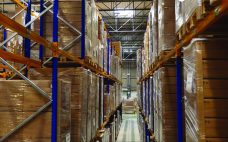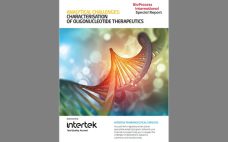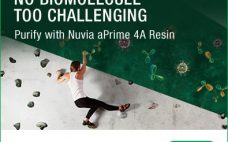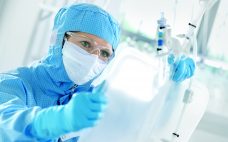This webcast features: Charles Meadows, Head of Product Management, Smart Consumables, Sartorius-Stedim Biotech Cell Culture expansion from vial to seed bioreactor is done by passaging culture through successively larger Erlenmeyer shake flasks. Sampling, media feed, inoculation and transfers are done non-aseptically by unscrewing the cap in a biosafety cabinet (BSC). Contaminated expansions due to non-aseptic technique are abandoned costing time and materials. Sartorius leveraged novel bottle closure manufacturing technology to create MYCAP® CCX. MYCAP® CCX combines tubing for aseptic fluid…
Sponsored Content
Going Beyond the Simple Customer–Supplier Relationship: Ensuring a High-Quality Supply Chain Through Transparent Partnerships
Operating a successful global supply chain to deliver single-use systems (SUS) for utilization in the biopharmaceutical industry is complex. In his insightful article, Claudio Catallo, Head of Global Supply Chain Management FMT at Sartorius Stedim Biotech, details the company’s intelligent approach to supply chain management and the models it uses. He also explains how expert teams and integration of digitalization across many sales, manufacturing, and distribution sites maintain the operational excellence required to support supply and demand in an ever-changing…
Critical Considerations for Fill–Finish Manufacturing: Demand to Increase Speed and Flexibility While Maintaining Sterility Spurs Adoption of Novel Technologies
The global market for biopharmaceuticals continues to grow at a rapid pace, with a 9.5% compound annual growth rate (CAGR) predicted over the next eight years. That translates into more than $500 billion in projected growth. So it is no surprise that biopharmaceutical manufacturers are investing heavily in new facilities, technologies, and pipelines for manufacturing drug products. Even so, the need to prevent contamination places stringent handling and packaging requirements on biomanufacturers. Sterilizing equipment often requires steam autoclaves and dry…
Analytical Challenges: Characterization of Oligonucleotide Therapeutics
Recent approvals of oligonucleotide therapeutics are a clear signal for optimism for this product class. This is supported by the strength of the current pipeline which has over 180 active oligonucleotide clinical programs in various phases of development. Improvements in analytical technology and know-how have played a key role in enabling suitable characterization and quality control strategies to overcome the difficulties associated with testing these complex molecules. Despite the lack of dedicated regulatory guidelines related to characterization or quality control,…
Single-Use Technology in Upstream Processing: A Roundtable Discussion
The Sartorius upstream portfolio addresses key strategic challenges facing the biopharmaceutical industry: Increased speed to clinic/market and lowered capital costs, with improved process control. Fully scalable, proven process solutions for cell line, media, and process development through commercial manufacturing accelerate upstream development and simplify manufacturing. Novel high-throughput development tools for intensified processes incorporate the latest in process analytics, multivariate data analysis (MVDA), and design of experiments (DoE) software tools. These tools are designed to compress development timelines and to scale…
A New AEX Mixed-Mode Chromatography Resin for High Selectivity and Recovery
This webcast features: Dr. Xuemei He, R&D Manager, Chromatography Media Chemistry, Bio-Rad Laboratories Biomolecules are becoming more diversified and complex. Bio-Rad’s newest hydrophobic AEX chromatography resin, Nuvia aPrime 4A, is engineered with distinct balance of ligand density and hydrophobicity. In this webinar, Dr. Xuemei He will introduce the properties of Nuvia aPrime 4A Resin. This mixed-mode resin is designed to facilitate selective and reversible binding of target molecules for higher purity and recovery over traditional chromatography resins. Case studies will…
The Proper Use of Extractables Data: Aspects Beyond Extractables Measurement
This webcast features: Dr. Armin Hauk, Lead Scientist, and Jean-Marc Cappia, Head of Segment Marketing Vaccines, at Sartorius Stedim Biotech The implementation and use of single-use system (SUS) in biopharmaceutical production is rapidly increasing and directly correlated with higher demands on Extractables and Leachables (E&L) information. Sartorius as a leader in SUS technology can look back on +20 years of experiences in the E&L area. This knowledge together with our current research initiatives enables us to progress and go beyond…
Risk Management of Biopharmaceutical Operations: End-to-End and Over Lifecycle
Biopharmaceutical manufacturing processes that were developed before the implementation of quality by design (QbD) typically use control strategies that are not founded on a formal understanding of criticality. Thus, manufacturers of “legacy” products lack the understanding of critical process parameters (CPPs) and critical quality attributes (CQAs). Introducing such elements to a legacy biologic drug product filing aligns fully with expectations described in the ICH Q12 guideline (e.g., increased process understanding and better risk mitigation strategies) (1). Here we discuss how…
Integrity Redefined: Consistent Robustness and Integrity Testing Lead to Enhanced Process Integrity and Patient Safety
With the increasing adoption of single-use systems (SUS) in critical stages of biopharmaceutical manufacturing, any lack of system integrity can significantly affect drug product quality and patient safety, as well as incur additional costs due to product loss and disrupted production cycle. This article from Sartorius Stedim Biotech, describes how determining the correlation between liquid leakage and microbial ingress can be used to define MALLs (Maximum Allowable Leakage Limits) of SUS for different process steps. The article also details the…
Ask the Expert: Acoustic Cell Processing
As cell and gene therapies approach commercialization, the industry is looking for scalable manufacturing solutions. Equipment providers need to design specifically for the good manufacturing practice (GMP) environment and the unique needs of cell and gene processing. On 3 April 2019, Kevin Lannon of FloDesign Sonics presented an “Ask the Expert” on one company’s solution. LANNON’S PRESENTATION In a typical cell therapy manufacturing process, steps that require washing, concentration, or buffer exchange include centrifugation, filtration, and counterflow filtration. Each has…









